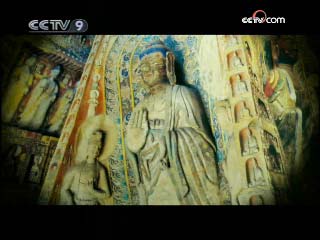------Program code: DO-081030-02526 (what's this?)
Source: CCTV.com
10-30-2008 09:05
The majestic David, the suffering Laocoon, and the silent Thinker; all are embodiments in stone of the human imagination. Mankind has cultivated a passion for framing moments of transient and impassioned emotion in stone.
 |
The sculpture Pietà by the great artist Michael-Angelo sits at the entrance to St. Peter's Basilica in the Vatican. It’s a depiction of the Virgin Mary holding the dead Jesus in her arms; her face expresses absolute calm and deep sorrow. Like many other western sculptures, Pietà communicates artistic beauty in an intimate manner that commands a sense of respect.
 |
Chinese sculptors, being more introvert that their western counterparts, chose not to fetch rock for carving. Instead they preferred to enshrine their gods in grottoes in secluded mountains, where pilgrims could visit.
At the time of the Northern Wei Dynasty in the 5th and 6th centuries, Wuzhou Mountain in Shanxi Province was heavily guarded. Emperors would visit the area and, facing north, the direction from where their ancestors had come, pray for good luck and for the country’s safety. Wuzhou’s highest peak is called Yungang, meaning “cloud ridge”.
On this peak, skilled craftsmen carved 45 grottoes. This group of vast grottoes extends for about a kilometre, and brings to the region a sense of grandeur, serenity and mystery. Statues of the Buddha sit high in these grottoes, surveying life in the mortal world below.
In the year 460, at the time of the Northern Wei Dynasty, a man appeared one day on Wuzhou Mountain. He wore a contented smile as he surveyed from above the passing travelers, caravans and soldiers. This man was Tan Yao, a renowned monk of his day.
The rulers of Northern Wei were the Xianbei people, and their conquests had won them control over China’s Central Plain. However, compared to the people they had subjugated, they felt inferior culturally. So they decided on a great project to prove themselves worthy rulers of the land they had conquered.
This great project was placed in the hands of Tan Yao, a man whose name is barely recorded in history.
The great project was the Yungang Grottoes, and would take 64 years to complete. It would receive funding and protection from succeeding dynasties. For Tan Yao and the pious men who followed in his footsteps, it was their life’s work. Yet, little mention of them has been recorded in history.
The Domed Ceiling
Grotto No. 3 is the largest of the Yungang grottoes. It is 25 metres high, equivalent to a 9-storey building. It reveals itself in its full grandeur when seen from below. The Apsaras carved on the ceiling are so lifelike that it seems that at any moment they will fly down and greet visitors. Its walls are covered with colourful paintings that adorn the grotto like evening stars. Its ceiling gives the impression of a depiction of the entire planetary system.
The ceiling, being domed, not only avoids the sense of repression created by a flat ceiling, but also makes good use of the principles of construction mechanics.
The top of the grotto has to bear the weight of the mountain, so it had to be made solid before the rest of the project could proceed. In fact, collapses did happen initially, much to Tan Yao’s frustration. Eventually, he received inspiration and found an unique solution to the problem.
Prior to their arrival on China’s Central Plain, the Xianbei people had lived in tents. It was these tents that were Tan Yao’s inspiration. Based on their design, he came up with the domed ceiling. It was called a thatched roof, because of the grass used to make it, which added an element of simple and natural beauty.
A piece of rectangular paperboard is taken and folded at its two ends to form right angles. It is then arranged between two building blocks. A coin is placed on top, and it trembles. Two coins, and it collapses.
The first rectangular paperboard is replaced with another piece. This time, before arranging it between the building blocks, it’s pressed from its two sides so that it protrudes slightly in the middle. If one coin is placed on top, it remains stable. Two coins, and it does not collapse. Another one, it’s still all right. Four coins, and it finally collapses.
The two experiments show that a domed roof can bear more weight than a flat one. A flat roof disperses any weight on it first to all its corners and then directly to the ground. Since the weight is focused in the corners, it collapses the moment the weight exceeds its ability to support it. But a domed roof disperses the weight in all directions and sends it down to the ground through the walls. The weight on a domed roof rests on the whole slant without any focus before being relayed to the ground. So the domed roof, because it offered maximum support, allowed the grotto project to proceed safely.
Tan Yao was responsible for five grottoes, and the introduction of the domed ceiling in them was a great success. The grand domed ceiling in Grotto No. 3 survives as an object of admiration until today.
